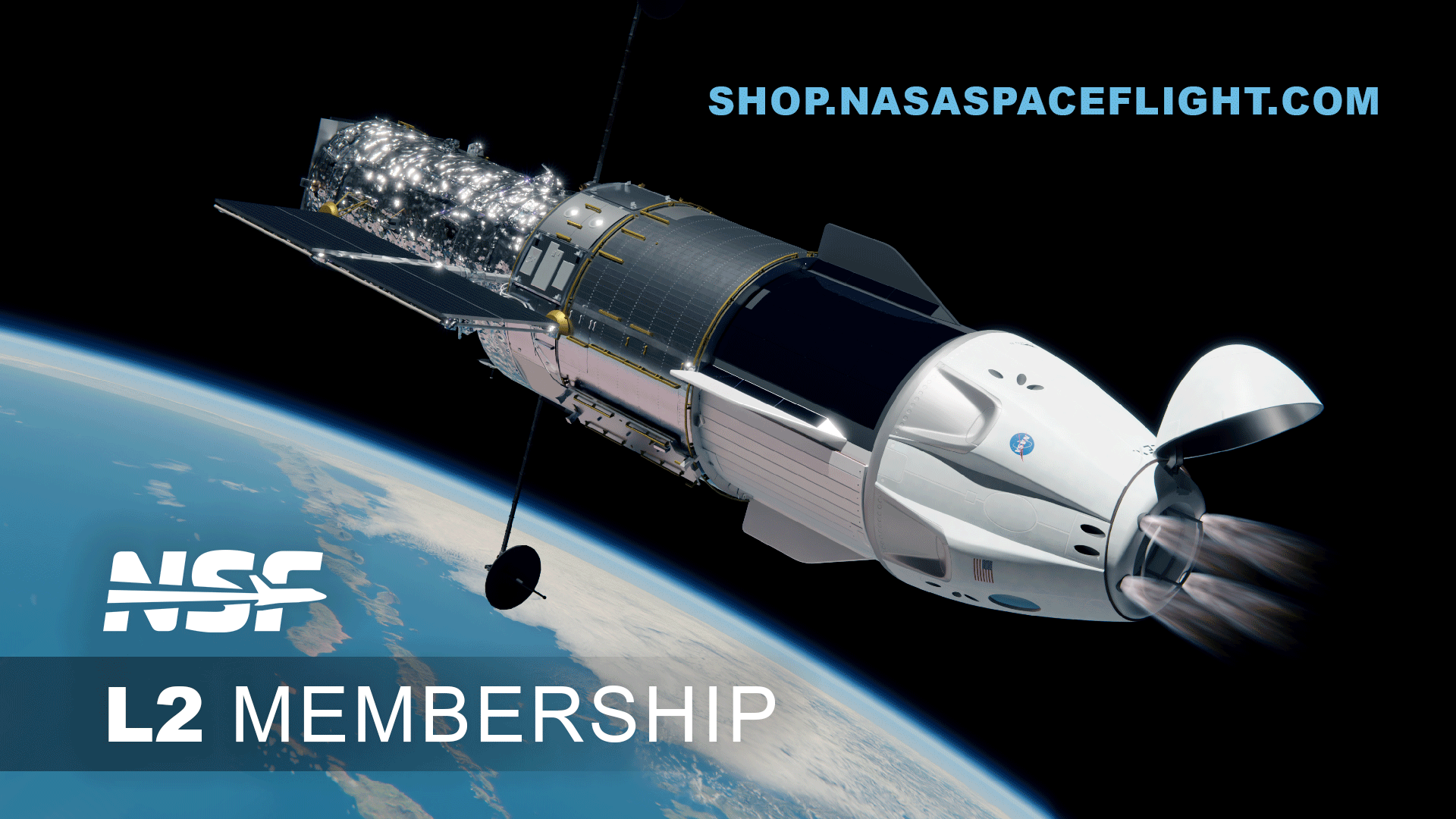After Hurricane Beryl passed through the Brownsville area without seriously damaging Starbase, preparations for the Starship 5 flight were advanced to a new level with the deployment of Booster 12 to the orbital launch site and the subsequent static firing on Monday, July 15.
While Booster 12 is being tested, stacking is also underway for Starbase’s second launch tower on Pad B, and the Starfactory has received new equipment. SpaceX is also proposing to increase Starship’s flight cadence from Starbase to 25 flights and landings per year, as hardware has been seen for Starship Block 2.
BOOSTER 12
The Super Heavy booster that will be used for Flight 5, Booster 12, was deployed from Mega Bay 1 to the orbital launch site on Tuesday, July 9, to be prepared for critical tests to prove the booster’s ability to fly. The booster was lifted onto the orbital launch pad A by Mechazilla’s “wand” arms that evening.
Booster 12 testing began with a partial propellant load on Thursday, July 11, and may have conducted tests related to propellant discharge after contact with the Mechazilla arms. On Friday, July 12, the booster conducted a 33-engine prime test. “Spin prime” occurs when the propellants are loaded and the engine turbopumps are spun up to flight speed, but the engines are not ignited.
This was the first spin test conducted on a Super Heavy since Booster 9 performed one in August 2023, possibly to test the booster’s internal upgrades or simply as a precaution to ensure the vehicle is functioning properly since there will be a capture attempt on Flight 5.
The next step after the rotation was initiated was the static firing. A static firing was conducted at 10:13 a.m. CDT (15:13 UTC) on Monday, July 15 and appeared to last eight seconds.
The thruster grid fins, used to steer the vehicle through the atmosphere for recovery at the launch site, were tested by moving them through their full range of motion. The spacecraft’s quick disconnect arm at the top of the tower was also moved several times to test its operation.
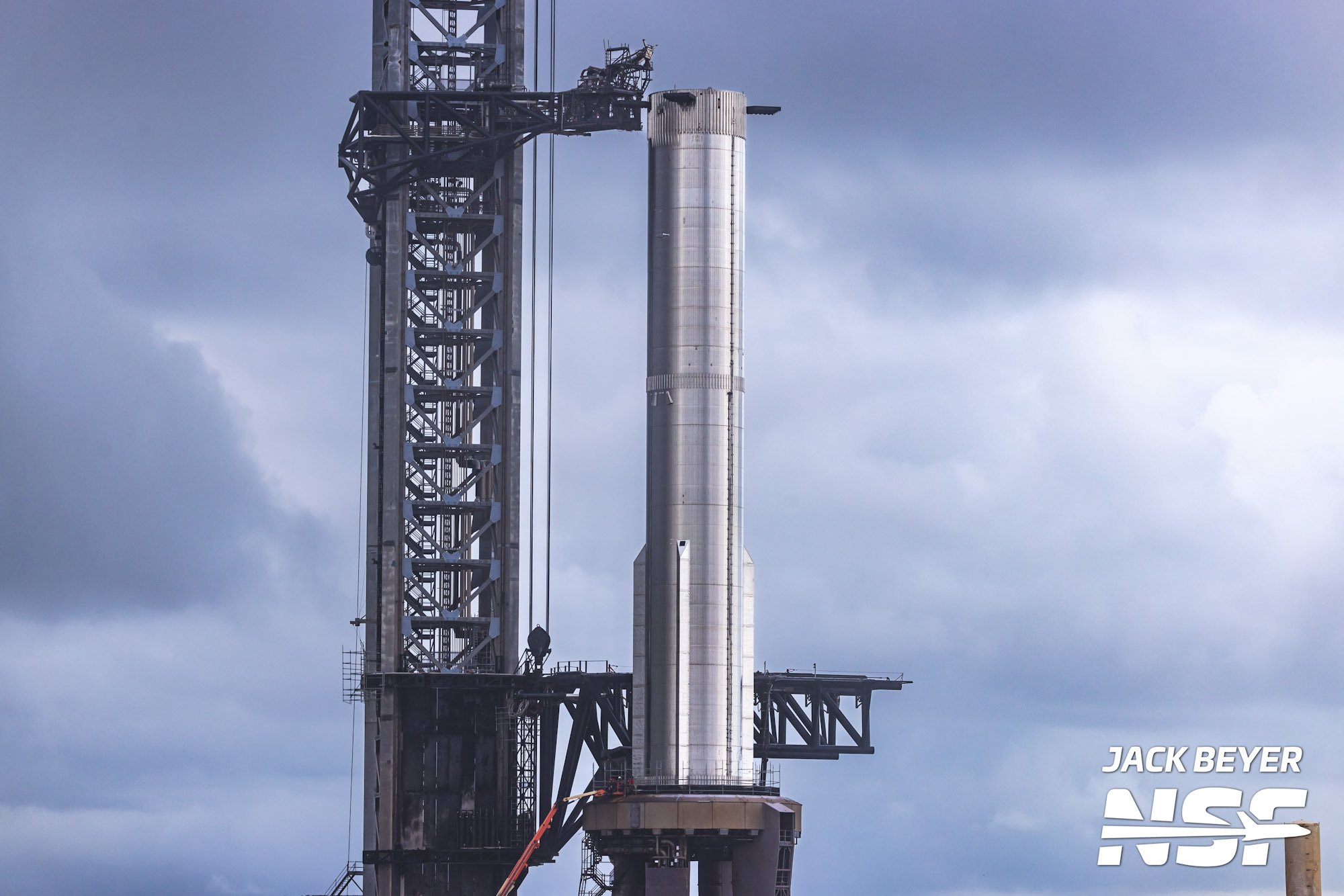
Booster 12 is on Launch Pad A ahead of pre-flight testing. (Credit: Jack Beyer for NSF/L2)
Booster 12 appears to have been upgraded over previous Super Heavy vehicles. These include a new Flight Termination System box designed to allow for rapid destruction of the rocket in the event of an anomaly. Four Starlink antenna mounts are also present, as well as new “remove before flight” covers for quick disconnects from the Raptor booster.
Closures are now scheduled for next week and may be used for testing, including the static shot that took place. The primary closure took place on Monday, July 15 from 6:00 a.m. to 6:00 p.m. CDT (11:00 a.m. to 11:00 p.m. UTC). Secondary closures are scheduled for Tuesday, July 16 and Wednesday, July 17 at the same times, but if the test is successful, they may not be able to be used.
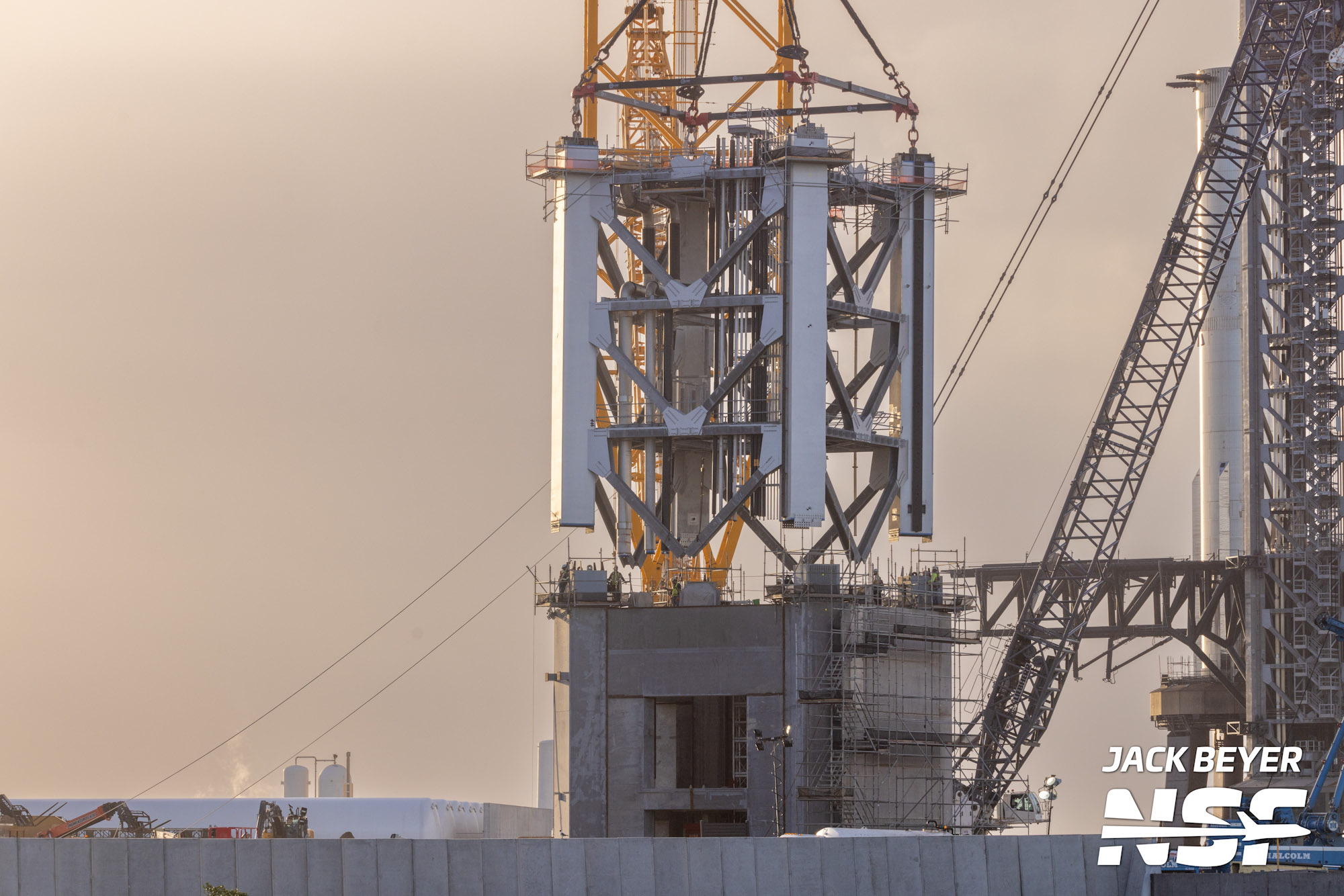
Module 1 of the tower is being lowered to the base of the Pad B launch tower at the orbital launch site. (Credit: Jack Beyer for NSF/L2)
NO LAUNCH B
The orbital launch site will be equipped with a second launch pad, which will allow SpaceX to increase the launch rate of the Starship program. Pad B, as the second pad is called, could also prove useful in case a problem prevents Pad A from operating for an extended period.
The base of the B-pad launch tower has already been installed and the base appears to have incorporated the lessons learned from the A-pad. The first element of the new launch tower has now been installed on the base. This segment was installed on 11 July and Tower Module 2 has now been deployed to the B-pad site.
In other Tower Section news, Tower Modules 4 and 5, with additional attachments to allow the quick disconnect arm to be moved higher on the tower to support future Starship versions, have been moved to Starbase from the Port of Brownsville. All nine modules of the new tower, which are pre-equipped with power and fluid lines, are now either at the Starbase Sanchez site or on Pad B.
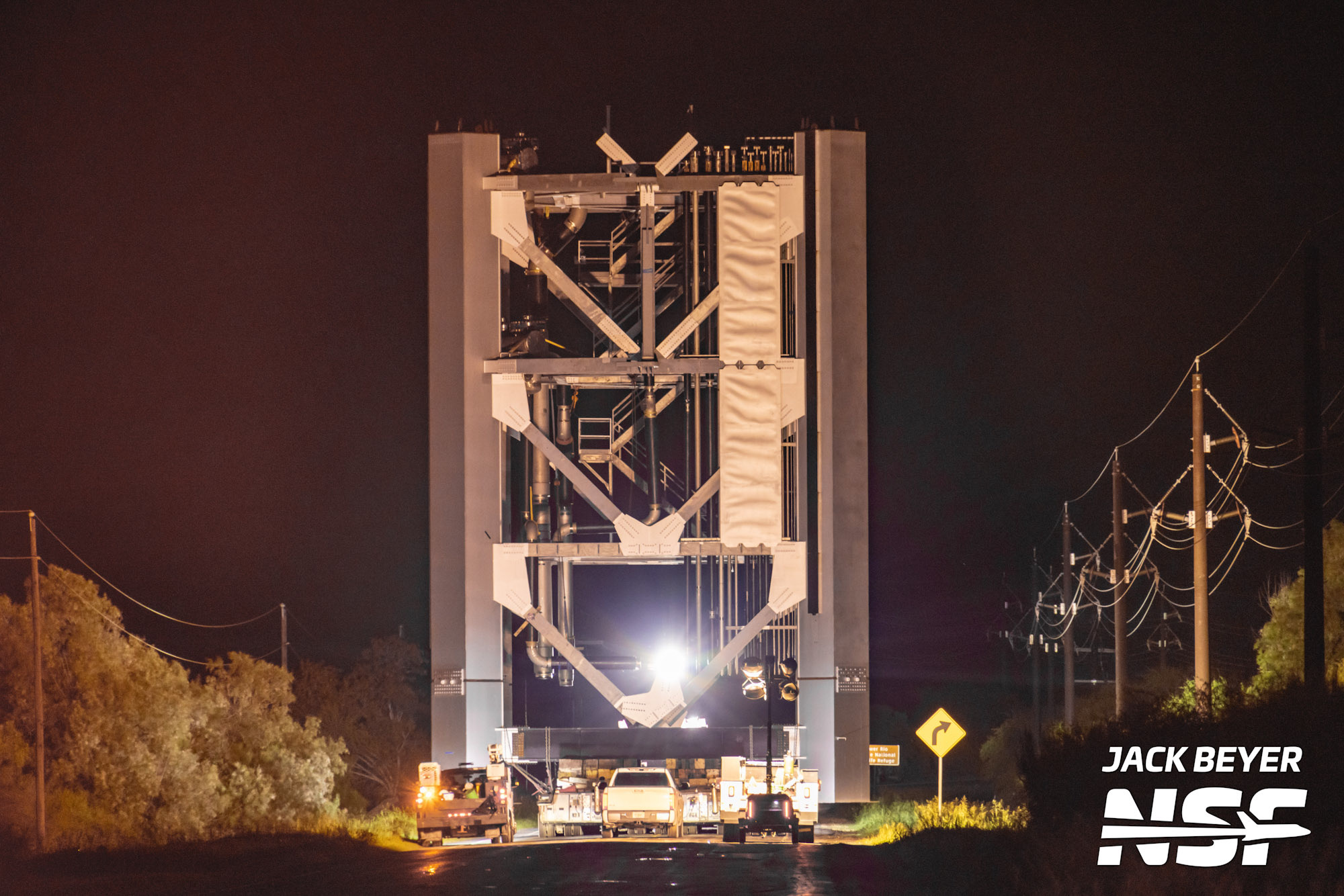
A tower module in motion after arriving in Texas. (Credit: Jack Beyer for NSF/L2)
Pad B is a key component of the increase in Starship’s launch cadence from Starbase, which SpaceX now proposes to increase to 25 Starship launches and 25 Starship and Super Heavy landings per year. SpaceX has filed a request with the FAA to increase the cadence from the currently authorized 10 launches per year, and the proposed tiered environmental assessment (EA) is expected to be released later this month. Public meetings on the proposed EA are scheduled for Tuesday, August 13, Thursday, August 15, and Tuesday, August 20, 2024.
Two meetings are scheduled for August 13. The first meeting will be held between 1:00 p.m. and 3:00 p.m. CDT (6:00 p.m. to 8:00 p.m. UTC) and the second meeting will be held between 5:30 p.m. and 7:30 p.m. CDT (10:30 p.m. UTC Tuesday to 12:30 a.m. UTC Wednesday, August 14). Both meetings will be held at the City of South Padre Island Convention Center.
We are committed to assessing the environmental impacts of all FAA-approved commercial space operations. We will hold public meetings on @SpaceX‘s proposal to increase the number of Starship/Super Heavy Vehicle launches and landings in Boca Chica, TX. https://t.co/nqmmKrVMcB pic.twitter.com/PGzamCSHa0
— The FAA ✈️ (@FAANews) July 12, 2024
The next set of two meetings is scheduled for August 15, with the first also taking place between 1:00 p.m. and 3:00 p.m. CDT (6:00 p.m. to 8:00 p.m. UTC). The second meeting will also take place between 5:30 p.m. and 7:30 p.m. CDT (10:30 p.m. UTC Thursday to 12:30 a.m. UTC Friday, August 16). This time, however, the meetings will be held at the Port Isabel Cultural and Event Center.
The final scheduled public meeting on the EA project is a virtual online meeting. It is scheduled for August 20 from 5:30 PM to 7:30 PM CDT (10:30 PM UTC Tuesday to 12:30 AM UTC Wednesday, August 21). In addition to flight cadence, this EA also discusses vehicle upgrades.
In addition to requesting up to 25 launches per year from Starbase, SpaceX also plans up to 44 Starship launches per year from LC-39A at Kennedy Space Center and up to 76 launches per year from SLC-37B. That will add up to 145 Starship launches per year — a rocket more powerful than the Saturn V that launched the Apollo missions to the moon.
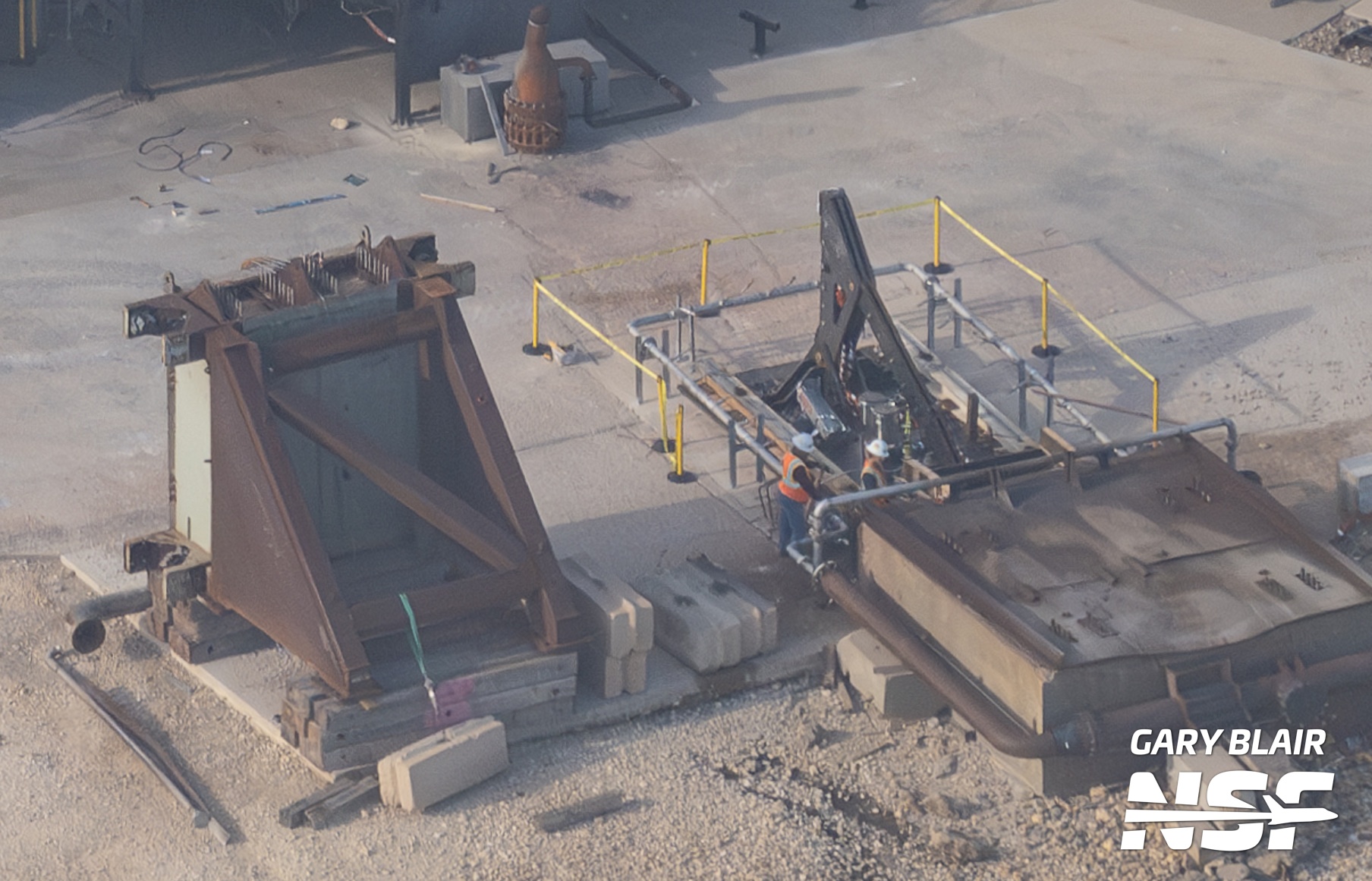
A redesigned support arm for the new orbital launch vehicle, seen during a flyby of SpaceX’s McGregor, Texas, facility. (Credit: Gary Blair for NSF)
STARFACTORY, SHIP 33, ETC.
The giant Starfactory has now received its gantry crane as it nears completion. In addition to the Starfactory, work on the Orbital Launch Site’s tank farm upgrades is also continuing. Work continues on the heat shield tiles for Ship 30 in the High Bay, and Ship 31 is in the Mega 2 Bay after testing at Masseys. Additionally, a nose section of Ship 33 – the first Block 2 vehicle – has been seen at Starbase.
The new version’s front fins are mounted further forward on the nose, away from the belly and its heat shield tiles, and they’re also thinner than the fins on the original flight version. A possible flight article of an operational payload bay for a Block 2 Starship was also seen, showing that SpaceX is closer to operational flights of the system. Full-size Starlink v3 satellites are expected to be the first operational payload that Starship will fly.
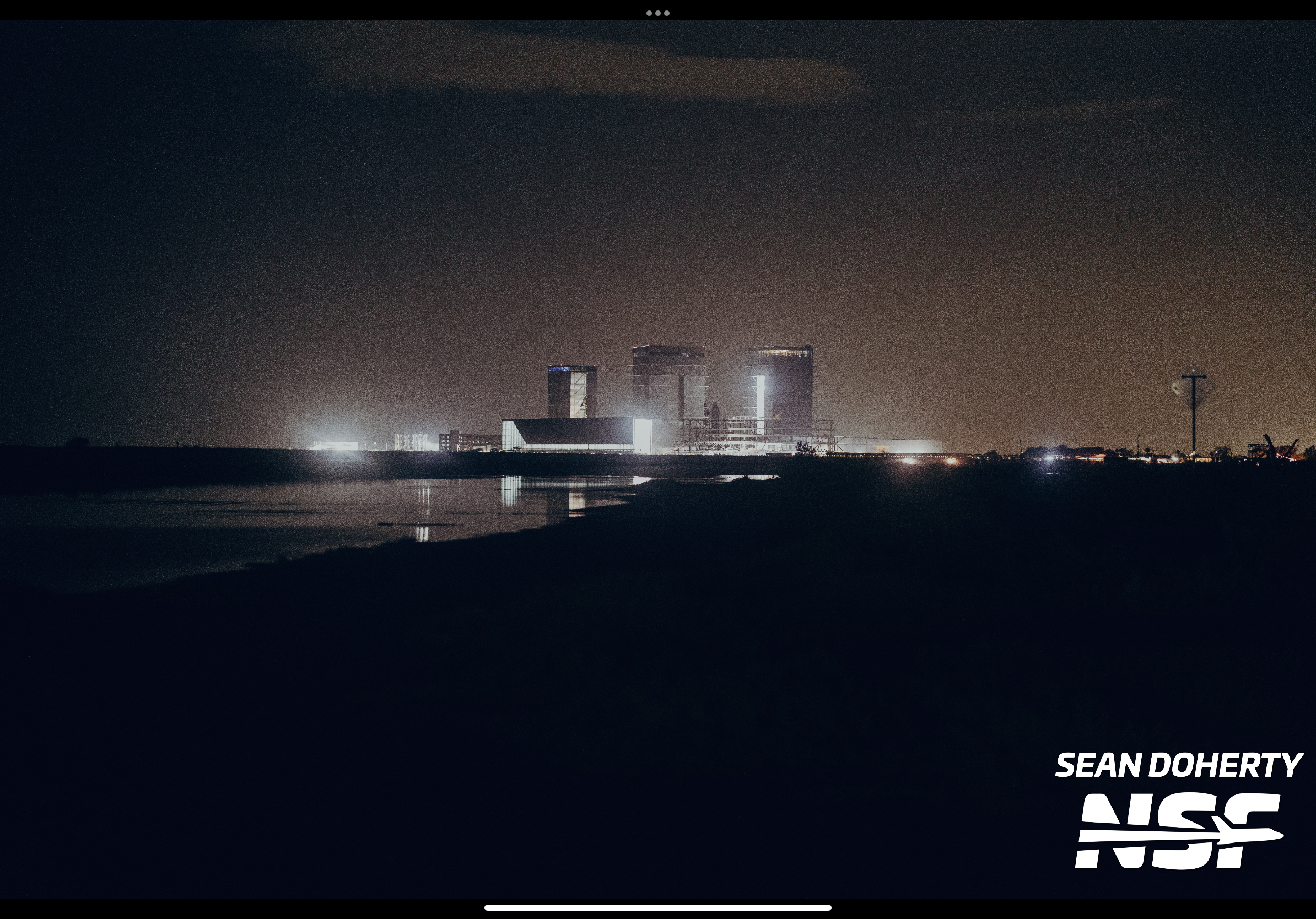
The Starbase skyline at night. (Credit: Sean Doherty for NSF/L2)
The tests Booster 12 is undergoing are important to the launch of Flight 5, but the flight’s schedule may depend on how long the heat shield upgrade on Spacecraft 30 takes. The FAA must also approve a license modification because of the planned booster capture attempt during the flight.
As preparations for Flight 5 are underway, the next version of Starship is taking shape and is being prepared to fly in 2025. Operational flights and their hardware are being developed, while the company’s currently operational satellite launcher – the Falcon 9 – is working towards a return to flight after the failure of Starlink 9-3 on July 11.
(Main image: Booster 12 test firing on July 15, 2024. Credit: Sean Doherty for NSF)
